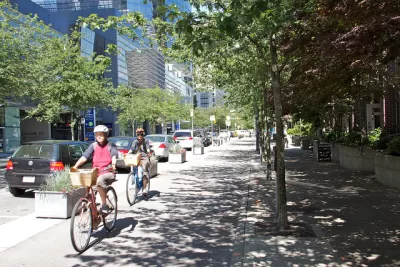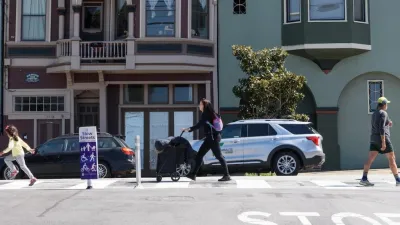Vancouver combined environmental goals and traffic safety goals.

David Goldberg shares the story of Vancouver's approach to street trees, and their benefit to traffic safety.
In the late 20th century, the city began to use traffic circles and curb bulges — or bulbs, as they’re known stateside — to slow traffic in residential areas, and quickly learned that the new spaces provided an opportunity for gardening. Vancouver’s popular Green Streets program recruits volunteers to tend gardens in the traffic calming spaces, with the city paying for the initial planting. In the 1990s, the city began converting side streets into “bike boulevards” and pursued a “greenways” plan that tore out asphalt and concrete in some places to make park-like streets where biking and walking were comfortable. Today, the city has 108 miles of such corridors.
According to Golberg, Vancouver's connection between trees and safety is a unique take on the "complete streets" concept of street design. Vancouver implements its street trees programs in accordance with the Renewable City action plan from 2015 and the Greenest City action plan from 2015. The city is also currently working on an integrated stormwater management plan.
FULL STORY: Thanks to Comprehensive Street Design, Vancouver Sows for the Future

Alabama: Trump Terminates Settlements for Black Communities Harmed By Raw Sewage
Trump deemed the landmark civil rights agreement “illegal DEI and environmental justice policy.”

Planetizen Federal Action Tracker
A weekly monitor of how Trump’s orders and actions are impacting planners and planning in America.

Why Should We Subsidize Public Transportation?
Many public transit agencies face financial stress due to rising costs, declining fare revenue, and declining subsidies. Transit advocates must provide a strong business case for increasing public transit funding.

Understanding Road Diets
An explainer from Momentum highlights the advantages of reducing vehicle lanes in favor of more bike, transit, and pedestrian infrastructure.

New California Law Regulates Warehouse Pollution
A new law tightens building and emissions regulations for large distribution warehouses to mitigate air pollution and traffic in surrounding communities.

Phoenix Announces Opening Date for Light Rail Extension
The South Central extension will connect South Phoenix to downtown and other major hubs starting on June 7.
Urban Design for Planners 1: Software Tools
This six-course series explores essential urban design concepts using open source software and equips planners with the tools they need to participate fully in the urban design process.
Planning for Universal Design
Learn the tools for implementing Universal Design in planning regulations.
Caltrans
Smith Gee Studio
Institute for Housing and Urban Development Studies (IHS)
City of Grandview
Harvard GSD Executive Education
Toledo-Lucas County Plan Commissions
Salt Lake City
NYU Wagner Graduate School of Public Service





























